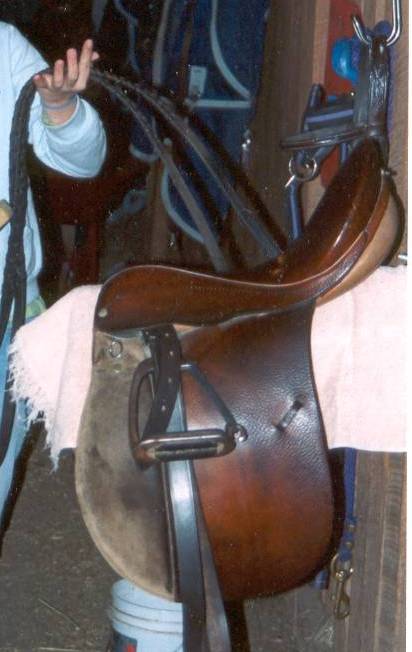Care and Cleaning of Horse Equipment

Next to your horse, the saddle and bridle are your most expensive investments when getting into horses. A saddle can cost anywhere from a few hundred dollars to a few thousand. Assuming you have a quality product, it can be a one-time investment if you take proper care of it.
In addition to looking attractive, regular cleaning of all of your leather goods extends the life of your tack. Leather will crack and break if it is left to dry out. On the other hand, if stored in a damp environment mold and mildew will cause it to rot.
After every ride wipe your bridle off with a soft cloth and give it a light coating of leather dressing. Be sure to clean the bit with a damp rag to remove bits of food and saliva.
The saddle needs the same attention after every ride. Wipe off mud, dust and sweat before it dries. If you use a leather girth treat it like the bridle. A cord or web girth can be rinsed with the water hose or in a sink or bucket of warm water and a little soap. Be sure to rinse the soap out thoroughly. Also clean any other equipment you use such as martingales or splint boots. It is very important that anything that comes in contact with the horse's skin be clean. Otherwise, dirt and grit will act like sandpaper, rubbing him raw the next time you ride, and cause saddle sores.
Give your tack a thorough cleaning on a regular basis. This means taking it apart and cleaning with saddle soap or other cleaning product made for leather. You must get into all the little nocks and crannies; use a toothbrush on tooled leather and hard-to-get-to places. After cleaning apply a leather conditioner to keep the leather supple. Tack made of synthetic materials can be cleaned with soap and water. Put in the shade to dry so the colors do not fade.
Clean the metal parts: stirrup irons, buckles, and decorative trim, with a metal cleaner or polish. Remove any that gets on the leather with a soft cloth.
If you are inexperienced, putting the bridle back together might seem like trying to solve a puzzle. Have someone check it to make sure everything is in the right place, and you haven't put the bit on up side down. I did that once, and it took my instructor a while to figure out why my horse was suddenly tossing his head!
There are dozens of leather cleaning products on the market. Trying to decide which one to use can be confusing. Some saddle makers recommend certain products to use on their brand of saddle, and it doesn't hurt to follow their advice. Old-fashioned saddle soap is still a favorite for many folks. Work up a lather with a damp sponge and then apply it to the leather and scrub. For conditioning leather, neatsfoot oil has been around a long time and is still popular. But, neatsfoot will darken leather over time. So, if you have a light colored saddle, use a product specifically for light colored leather.
If you live in a humid climate, consider using one of the products that prevents mold and mildew. You can also find leather dressing that has a waterproofing agent. The choices are many; most catalogs devote a couple of pages to leather care products. You may choose from several different forms including solid, liquid, paste and ready to use wipes, similar to baby wipes. The common ingredients of these various products include bee's wax, lanolin, glycerin, vegetable oils, and mink oil. But the most important ingredient in taking care of tack is "good ole elbow grease".
Set aside time from your riding to clean your tack. It will benefit your horse and your budget.
© 2008 Donna Campbell Smith








